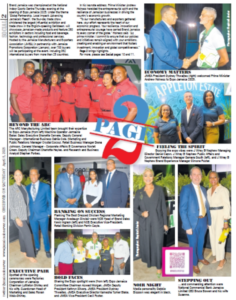Deadly love triangle — conclusion
ON December 10, 1986 Joseph Zaidie and Paulette were married, unknown to Linton Berry, with whom she was said to have been having an affair.
The judge and jury in Berry’s murder trial heard that ten days later — after the newlyweds returned from a trip to Miami, USA — that Berry telephoned Joseph Zaidie and apologised for his earlier threats. He wished the couple well and asked for an assurance that his hitherto untoward behaviour would not be reported to the police.
As it turned out, there would be no end to the torment. For, as the court was told, on the early morning of January 9, 1987, Zaidie received a telephone call from Berry; who this time instructed Zaidie to come forthwith to Paulette’s former apartment in lieu of his (Berry’s) continued detention of her there. Zaidie did not take up the offer.
At about 1 o’clock in the morning, Berry arrived at Zaidie’s home. Paulette arrived shortly after in her husband’s jeep.
In a conversation that followed, this is what Zaidie reported that Berry told him: “He was still in love with Paulette and he was very upset that she had gotten married to me.”
Upon being told by the Zaidie that the marriage was, as it were, “a done thing”, and that he should, therefore, cease his molestations and threats, Zaidie testified further that Berry got into “a vile temper”. He threatened that he would shoot Paulette if he discovered that she had gotten married while she was still seeing him.
Ziadie recalled for the court an occasion when Berry allegedly threatened to kill him because he had learnt that Zaidie had hit Paulette.
On January 11, 1987 at about 10:15 pm, Berry carried out his threat to kill Paulette, shooting her in the face at the foot of Jack’s Hill, St Andrew.
He then called Zaidie to relay the news by phone.
It was the worst phone call Joseph Zaidie had received in his life, he told the court later. In that instant his life changed forever.
Zaidie also described for the court the condition of his wife’s body when he visited the death scene that January night, saying her face had been “completely blown away”.
Zaidie’s cross-examination was centered around his credibility. Questions were posed in relation to his alleged abuse of women, including his deceased wife; that he had, among other things, trafficked in hard drugs — specifically cocaine — and that he had introduced that drug to his wife.
All of the above postulations he stoutly denied. He did admit, however, that he had been “warned off” for breaches of the Racing Commission Regulations.
Another key prosecution witness, Daphne Matadial, the sister of the dead woman, also gave evidence.
It was her testimony that on an occasion in October 1986, Berry admitted to her in the presence of her sister, Paulette, that he had “beaten, threatened to kill and terrorised Paulette by wearing a mask.” He did those things, he said, because of Paulette’s refusal to go out with him.
When Matadial told Berry that Paulette wished to end the relationship because she could no longer endure his ill-treatment, he promised to mend his ways.
Matadial recounted other instances when she said she had to speak to the accused about his abuse of Paulette, including his “beating her; threatening to kill her; standing in her belly and wounding her in the head”.
She testified that on January 7, 1987 Berry visited her (Matadial’s) home. He complained to her about her sister going off to marry Zaidie without informing him. He told her he was willing to have her sister back and offered to set up Paulette in Miami until the rumours died down. He added that Zaidie could not provide for Paulette as he could.
Then the inevitable happened, according to the prosecution.
Paulette was on her way home some time between 9 and 10:00 pm on January 11, 1987. She was seen proceeding easterly on Barbican Road when another car pulled up beside hers. She stopped.
Melrose Spence, who testified that he was a friend of the accused, said he was in the area that night when he saw Berry sitting on the bonnet of his car. Berry appeared to be in conversation with someone in a Jeep. The door to the driver’s side of the Jeep was ajar.
Another witness, John Johnson, told of hearing one gunshot; then another. He saw one car reverse and shoot up Jack’s Hill Road “like a jet”. Paulette Zaidie was dead.
Evidence by the government pathologist revealed that the bullet entered below the left ear in the lower cheek, shattering the lower jaw-bone, the left carotid artery and the jugular vein and made its exit to the right side of the mouth in the cheek.
Death was due to shock from haemorrhage, caused by a single bullet fired at point blank range.
The ballistics expert called by the prosecution, revealed that what was described as “the fearsome weapon” used to commit the crime — the .44 Magnum Smith and Wesson revolver – fitted with a hammer block safety mechanism, was in proper working order on the night of the incident and, in other words, could not have gone off accidentally. He added that the weapon could only have been fired if the trigger was fully pressed back.
Berry’s defence
Linton Berry gave evidence on oath.
He told of talking to and making arrangements with Paulette to meet with her that fateful night at the gas station at the intersection of Jack’s Hill and Barbican Roads. He said he got there and parked his white Honda motor car to the left of her Jeep Wagoneer. She told him she wanted to leave her husband that very night. He tried to dissuade her by suggesting she should discuss it with her husband first.
According to Berry, at that point they both left their vehicles and embraced each other. Upon releasing him, he told the court, Mrs Zaidie said she intended to get into his car. According to him, as she made to pass by him, and while his arms were still around her shoulders, she grabbed his gun which was then in its holster.
He said he grabbed the weapon with both hands and forced it downwards from his waist. Although his finger was not on the trigger, he declared, he suddenly heard an explosion. That shot went through the left door of the jeep. He regained possession of the gun, holding the weapon in his right hand. He then picked Paulette up bodily with his left arm and forced her into the seat of the Jeep, behind the steering wheel.
Berry told the judge and jury he was compelled to use force because the deceased had been struggling. He went on to say that he had put his right hand with the gun held upside down against the door pillar of the jeep for support and was in the process of switching on the head-lights and the ignition, when he felt a sudden jerk against him and heard another explosion.
He looked and saw that Paulette had been shot in the head. He shook her several times, calling her name, but she was dead. He told the court he left the scene with the gun. He believed the deceased was under the influence of drugs.
Berry demonstrated for the jury how he said this unfortunate tragedy occurred. He denied that he had shot Paulette Zaidie deliberately. He also denied that he had been careless or negligent with the weapon.
The accused also denied that he had made any telephone confession to Joseph Zaidie that night. He further denied that he ever made any threats against Paulette as alleged by Zaidie and the dead woman’s sister.
Some hours after the killing, Berry turned himself in to the CID Headquarters with his attorney. Cautioned, he was advised by his legal advisor not to say anything and remained silent as a result.
The investigating officer in this case was Superintendent Dudley Reynolds (now retired Assistant Commissioner of Police) and the case would eventually reach the UK Privy Council, after Berry was found guilty of murdering Paulette Zaidie and appealed.
The Privy Council sent back the case to be retried.
An important point of legal interest in all this was the production of an addendum to Matadial’s earlier statement to the police, as the Privy Council noted: “to assist the Judicial Committee of the Privy Council in relation to the conduct of the appellant’s trial.”
Their Lordships expressed both surprise and disappointment that “right up to the time when this appeal was heard by the Board, no information has been forthcoming to explain how the addendum came into existence…” among other things.
‘What Their Lordships find still more important in this case is that important evidence was adduced which had not been foreshadowed in the depositions. They consider that it was the Crown’s clear duty to give advance warning of that evidence by furnishing the three statements to the defence. Failure to do this was in their Lordship’s view a material irregularity. R. v. Maguire {1992} 2 WLR, 767 at page 782.”
Turning to the complaint by the defence that the learned trial judge “failed to deal with the problem which the jury indicated they had when they returned to court after an hour’s deliberation”, the Privy Council had this to say: “Having ascertained that the problem related not to the law but to the evidence… the judge then gave a brief and accurate summary of the factual contest, adverted again to the burden of proof and reminded the jury that they were the sole judges of the facts.
“But he did not find out what was the problem which had brought the jury back into court and it is therefore impossible to tell whether anything said by the judge resolved the problem or not, because no one knows what the problem was.”
In the result, having referred to several stated cases on the point, their Lordships in reference to the case of Anderson v. R. {1972) A.C. 100, went on to say: “In cases of murder, great care must be taken to see that there has been no miscarriage of justice” and the test, a strict one, has been described in Woolmington as whether “if the jury had been properly directed they would inevitably have come to the same conclusion”.
The Law Lords also referenced Stirland v. Director of Public Prosecutions {1944} AC. 315 as involving “a situation where a reasonable jury, after being properly directed, would on the evidence properly admissible without doubt convict”.
Finally this: “The case against the appellant was indeed a strong one and for that reason their Lordships would not be prepared simply to recommend that an acquittal be ordered, but they do not feel able to say that the jury would inevitably have convicted if the defence had been furnished in advance with the three statements in question, and if the jury had received the accepted direction on evidence as to character and guidance from the trial judge on the problem, whatever it was, indicated when they first returned to court.”
Berry was retried and again found guilty. He is now serving a sentence of life imprisonment at the Tower Street Adult Correctional Centre.
Linton Berry is the only son of Hugo Berry and his wife, Joyce, widely known for many years as “Man Joyce”, one of the foremost bicycle importers, repairers and traders of bicycle parts from the early days of cycle racing at the Kingston Race Course, now National Heroes’ Park. They operated on Hagley Park Road, just north of the crossing with the Waltham Park Road traffic lights. Both his parents died in the years between the two murder trials.
Next week: The diplomat, the maid, an extra-marital affair and a murder
Comments on the crimes that rocked the nation series
* Dear Sybil, I am a Jamaican residing in Santo Domingo. I enjoy your articles. Do you have anything on Ivanho “Rygin” Martin, and the Reubel and Dias Cuban murderers? If so could you publish what is available? A million thanks in advance. – David M Lindo, davidmcwlindod@hotmail.com
* Dear Sybil, this is the second (deadly love triangle) in your series of articles that I have read and find them most intriguing. I would like to suggest to you to write a book of short true stories based on the series. This could read like a novel where each chapter is a different story. Imagine travelling on a two-hour flight and having such a book to read! I truly encourage you to consider this. –
Howard Bennett, howardbennett02@gmail.com
Sybil E Hibbert is a veteran journalist and retired court reporting specialist. She is also the wife of Retired ACP Isadore Hibbert. Send your comments to allend@jamaicaobserver.com















